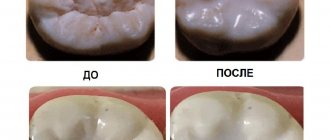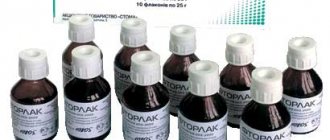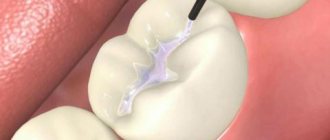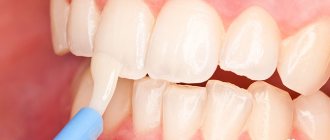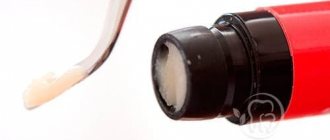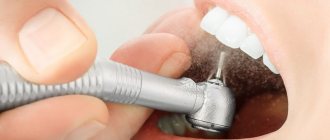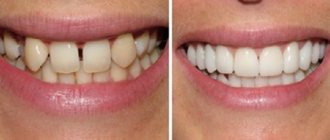Fissurit is a white, light-curing sealant that is increasingly being used for dental purposes.
Due to its composition, this material combines well with any type of enamel and does not betray its presence in any way after application to fissures. It is quite easy to use using special small syringes.
The main purpose of using Fissurite is to seal fissures, seal damage to tooth enamel, high-quality fastening of various orthodontic devices, create a protective layer for cement or plastic fillings, as well as restore the normal state of the fillings themselves after they are damaged.
What is a fissure of a tooth?
In Latin, fissure means “gap”. But this is a literal translation. In reality, fissures are more like grooves or grooves located among the cusps that make up the molar tooth. That is, they are of natural origin. However, these grooves change throughout life. At first they are shallow and have a smooth, flat bottom. Over time, the grooves between the sides of the tooth's cusps move downward, forming a deeper, inward-facing angle.
Thus, a fissure is a notch on the surface of a chewing tooth that cuts its enamel. This phenomenon can lead to caries. In such grooves, framed by the sharp edges of the tooth, food debris quickly accumulates, which can rot. Rotting causes the fissures to deepen.
Brushing your teeth will not help remove stains. Bacteria living in the oral cavity cope with plaque, but produce acid, which negatively affects the teeth and leads to the formation of caries.
Fissurit (Fissurit F, FH): instructions for using sealant
Fissurit is a white, light-curing sealant that is increasingly being used for dental purposes.
Due to its composition, this material combines well with any type of enamel and does not betray its presence in any way after application to fissures. It is quite easy to use using special small syringes.
The main purpose of using Fissurite is to seal fissures, seal damage to tooth enamel, high-quality fastening of various orthodontic devices, create a protective layer for cement or plastic fillings, as well as restore the normal state of the fillings themselves after they are damaged.
Composition and release form
Fissurit is sold in the form of a low-viscosity mixture, which is contained in special small syringes. The syringes come with a variety of tips that differ in length and shape. There can be 20 pieces in packages.
There are several varieties of this remedy: Fissurit F and FH. Both options contain fluorine, but the FH version has a large amount of special filler (here it is more than 50% of the composition).
Material properties
The sealant contained in Fisurit, after being applied to tooth enamel, acquires an appearance that is practically indistinguishable from the tooth itself.
After appropriate dental treatment, it quickly hardens, forming a durable protective layer for the teeth, preventing the occurrence of caries and the accumulation of dirt in small fissures.
Due to the presence of fluoride, a lining made from such material takes on the effects of the most aggressive substances that come into contact with the teeth, which additionally protects them from rapid destruction.
Purposes of application
Fissurite is actively used to solve the following dental problems:
- high-quality sealing of fissures on enamel;
- sealing baby teeth;
- sealing carious cavities;
- restoration of damaged fillings;
- to protect fillings made of some relatively soft materials from moisture and other destructive factors;
- fixation of orthodontic treatment devices;
- restoration of damaged enamel and other tasks.
How to use
The technology for using this product requires great precision and accuracy, which is why the material is used only in a dental clinic.
The dentist must adhere to the following sequence of actions:
- First, the enamel must be thoroughly cleaned of any contaminants to a natural white color. Then it is washed and dried well.
- Next, you need to perform etching. To do this, a special solution is applied to the tooth with a brush, which is kept there for 15-20 seconds and carefully removed. The tooth is washed again and dried well.
- Only now can the dentist begin to use Fissurit, squeezing the material through a syringe into the desired location. The finished coating must be polymerized and thoroughly polished.
If the tooth surface has not been completely dried before treatment, this increases the likelihood of poor sealing of the applied sealant.
If the enamel surface is dirty after etching, it will affect the adhesion of the material. With the help of special bonding you can make adhesion normal.
Fissurit should not be placed under constantly operating lighting (operating lamp), otherwise its polymerization will begin prematurely. All work must be performed with preliminary fluoridation. This way you can protect your tooth from the development of caries.
As for the cost of this material, it is around 38-40 dollars per package.
dentazone.ru
Forms
Depending on the shape of the fissure, there are four types.
Funnel-shaped fissure
This form is the safest from the point of view of caries formation. After all, the type of funnel makes the furrow more open, and this does not allow the remaining food to get stuck. That is, food debris is washed out of the fissure on its own. In addition to the increased openness of the funnel-shaped form, its good mineralization can be noted as an advantage.
Cone-shaped fissure
This type of tooth cavity already creates conditions favorable for the accumulation of food debris. And the liquid collecting in the oral cavity directly affects the course of mineralization. However, careful control of the quality of brushing your teeth will help get rid of even the smallest food debris.
Drop-shaped or flask-shaped fissure
Its main characteristic is a very low level of cleanability. The structure of this groove is such that a toothbrush is not able to cope with the removal of all remaining pieces of food and other microorganisms. This situation is favorable for the development of caries.
Polypoid fissure
In many ways, it is similar to the drop-shaped form: the features of its structure lead to a slower mineralization process. This increases the risk of tooth decay.
Thus, the depth of the recess and the degree of complexity of its structure increase the risk of developing caries.
When should you resort to sealing?
The process of filling the grooves and grooves formed on the chewing teeth with a specialized product is called fissure sealing. The substance used during the procedure prevents the smallest microorganisms and pieces of food from entering the tooth grooves.
Essentially, the tooth is sealed and is inaccessible to the influence of harmful factors. The means by which sealing is carried out, as a rule, includes fluoride ions, and this makes the enamel resistant to the threat of caries.
The described procedure is performed for both adults and children. Both baby and molar teeth can be “sealed” with a special substance, since caries affects people of any age. However, in children the process of fissure mineralization is lower, so the possibility of enamel defects increases.
There are several indications for this procedure:
- the presence of teeth whose fissures have a complex structure and great depth, which leads to the accumulation of food debris in the grooves;
- the appearance of signs of caries;
- encountered when brushing teeth ;
- identification of pigmented fissures, that is, areas of enamel that are most susceptible to caries;
- the presence of teeth that are not yet four years old.
Indications for sealing are the appearance of weakly mineralized areas on the teeth, as well as the identification of areas susceptible to caries. A professional doctor, after checking the structure of the grooves, will immediately be able to determine the need for this procedure.
Why can our articles be trusted?
We make health information clear, accessible and relevant.
- All articles are checked by practicing doctors.
- We take scientific literature and the latest research as a basis.
- We publish detailed articles that answer all questions.
On the other hand, sealing will be contraindicated if the oral cavity is not well maintained. First, you will need to remove tartar and plaque and teach the patient how to properly care for their teeth. Also, the procedure cannot be carried out if the tooth openings are very wide and connected to each other. In this case, the sealing material may not be applied correctly.
Material properties
The sealant contained in Fisurit, after being applied to tooth enamel, acquires an appearance that is practically indistinguishable from the tooth itself.
After appropriate dental treatment, it quickly hardens, forming a durable protective layer for the teeth, preventing the occurrence of caries and the accumulation of dirt in small fissures.
Due to the presence of fluoride, a lining made from such material takes on the effects of the most aggressive substances that come into contact with the teeth, which additionally protects them from rapid destruction.
Sealing methods
There are two main methods of sealing. The choice of one type of procedure or another is determined by the condition of the tooth surface.
Non-invasive fissure sealing
It is carried out when the patient has grooves that are unable to get rid of pieces of food and plaque using saliva and brushing the teeth. The non-invasive form does not involve surgical actions. A set of actions that the doctor will perform:
- cleans the tooth surface from the plaque layer;
- will work to make the edge of the tooth rough, as this is necessary for a stronger fixation of the sealant;
- apply sealant and secure it; the type of working material will determine how the operation to harden it will take place; in some cases special light is used.
It happens that the hollows on the chewing edge of the tooth are closed. This makes it difficult to clean them and then fill them with sealing material. In this case, the doctor will have to open the recesses using mechanical force.
Invasive fissure sealing
This method is used more often when the patient’s tooth enamel is almost completely formed and is approaching the final stage of formation. It was at this time that two circumstances converge at once: on the one hand, the enamel is not yet fully formed, on the other hand, plaque could already have accumulated in deep and closed fissures. The problem of getting rid of plaque will be solved by sealing by mechanically expanding the recesses.
The use of this method has an advantage over conventional filling, even if we are talking about caries that have already begun. A filling that is familiar to everyone, when applied to a tooth, covers at least ¼ of the chewing edge of the tooth. While the use of sealant reduces the coverage area by up to 5%.
To increase the width of the fissure and level its edges to the full depth, a diamond bur is used. Expansion and leveling are necessary to ensure that the sealant material properly fills the furrow cavity. In addition, this stage of sealing will help to detect those areas affected by caries that were not identified during a superficial examination.
When signs of caries are detected during the expansion of the fissure, the doctor must first take all measures to eliminate them. Only after removing the caries lesion can sealing begin.
When resorting to any of the described sealing methods, you need to understand that this operation is temporary. If the enamel of the chewing teeth is fully formed, then the presence of sealant no longer plays a big role, since the teeth have received the stability they are entitled to by nature and are now able to cope with some problems on their own. But this ability will only be preserved if you perform all hygiene procedures and periodically visit the dentist.
Purposes of application
Fissurite is actively used to solve the following dental problems:
- high-quality sealing of fissures on enamel;
- sealing baby teeth;
- sealing carious cavities;
- restoration of damaged fillings;
- to protect fillings made of some relatively soft materials from moisture and other destructive factors;
- fixation of orthodontic treatment devices;
- restoration of damaged enamel and other tasks.
